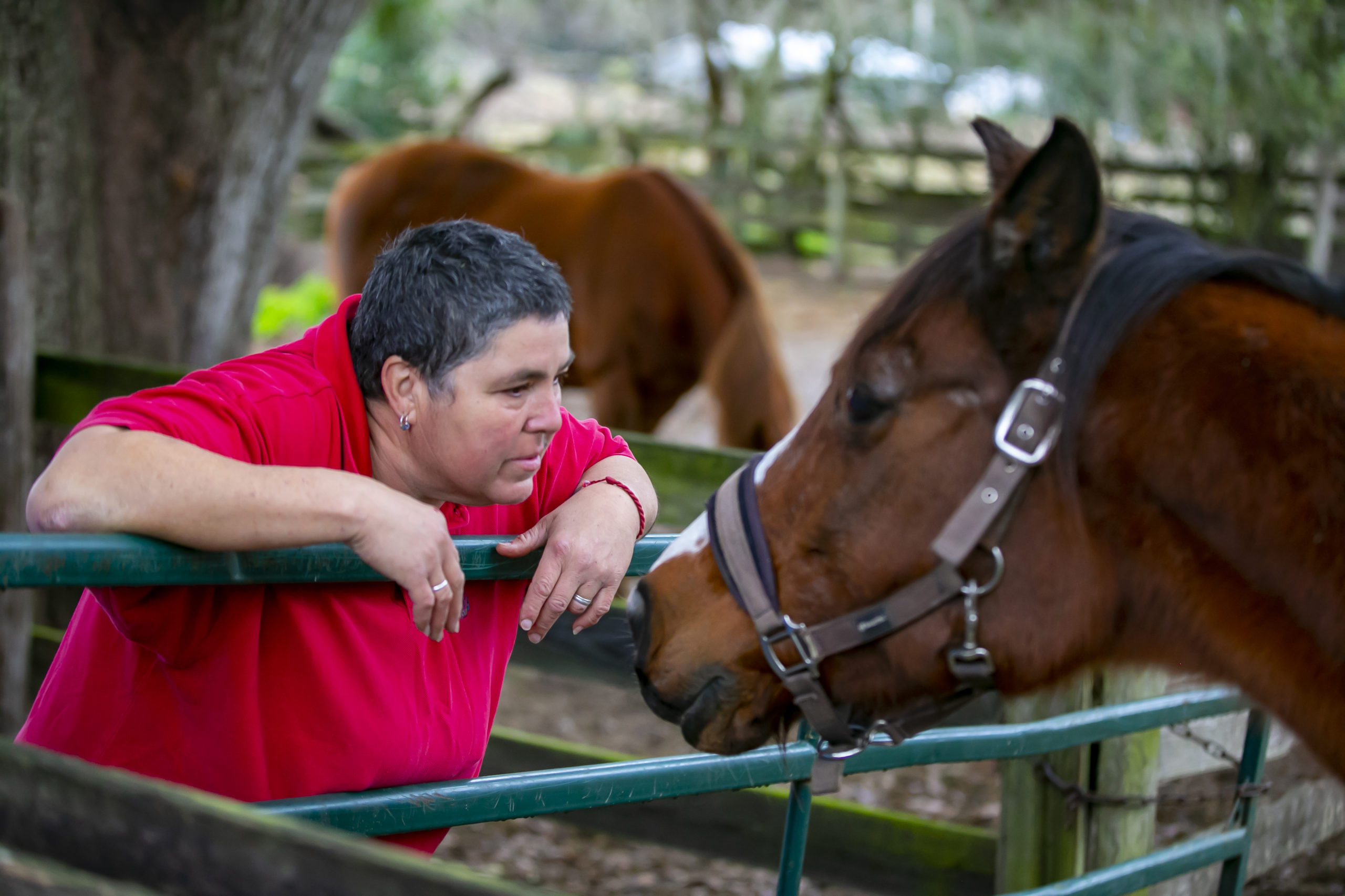
Meet the force of nature behind this lifesaving animal rescue that gives help to the hopeless.
There’s a wondrous thing that happens when Rosie Gutierrez crosses the barnyard at Sweet Water Rescue and Rehab in Williston. In fact, the good-natured and self-effacing 57-year-old could easily be mistaken for a modern-day Dr. Doolittle by the way her devoted flock of cats and dogs gather around her and assemble into a quirky procession of proud followers.
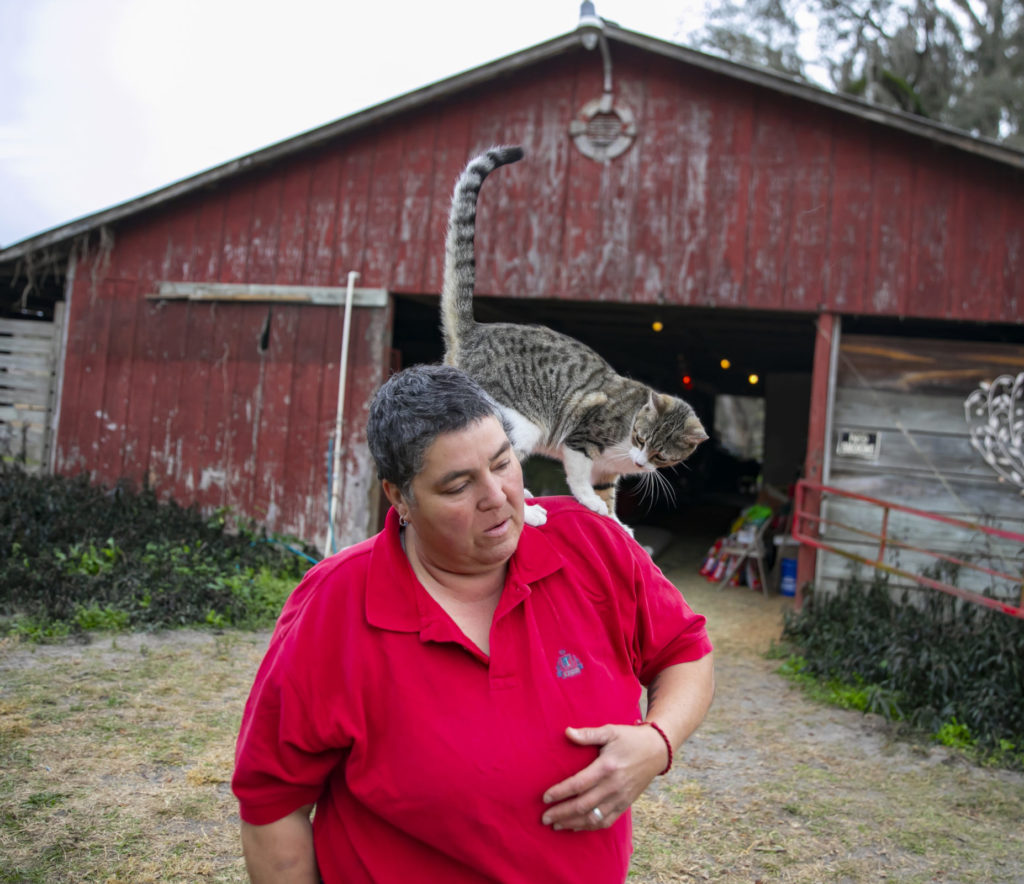
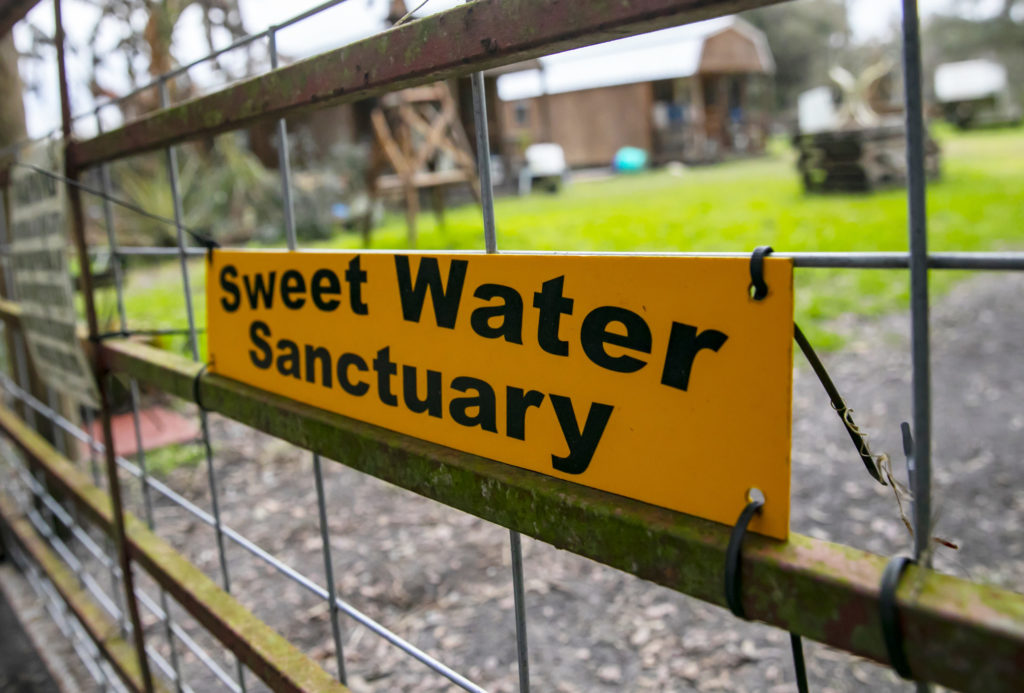
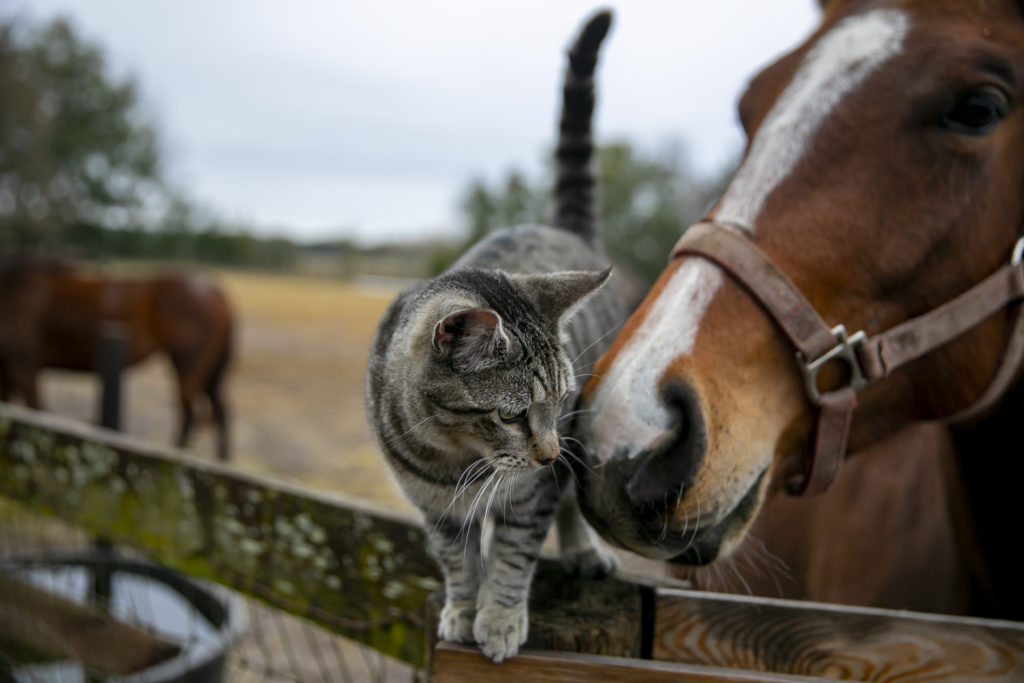
The first time I visit this rustic farm sanctuary, I am astounded by a literal sea of cats lounging in the open field in front of the main barn. I expect them to scatter and flee as we make our way across the property and while a few dart here and there, the majority are remarkably relaxed and several come over to greet me.
As the various residents approach, Gutierrez calls out their names and offers biographical tidbits.
“That’s Miss Moneypenny,” she explains. “Roger Moore and Sean Connery are around here somewhere.”
Then there are the cast of pop culture icons including Ella Fitzgerald, Otis Redding, Thelma and Louise, Lil Wayne, Nicki Minaj, Tarzan and Chanel, to name a few.
“People ask me, how can you remember all of their names?” says Gutierrez. “I’m the one who names them, so it’s easy. And they all know their names, believe it or not. There are so many that come in, aft er a while you have to find new themes. For instance, there’s Merlot, Chardonnay and Sangria. We had Elizabeth Taylor Swift . She was a Siamese and she had the bluest eyes, like Elizabeth Taylor, but she was blonde like Taylor Swift , so she ended up with two names.”
Her current residents include more than 100 cats, dogs, horses, miniature horses, donkeys, rabbits and pigs. She has also homed goats, ducks and chickens.
“She’ll take any animal,” asserts Hank Walker, who learned of Gutierrez’s commitment firsthand when he and a group of likeminded animal advocates were trying to save a medically needy dog from euthanasia. “Most of the animals that come there have been mistreated. I consider it to be a bit like the land of misfit toys and she is completely focused on taking care of them.”
Gutierrez also works with community advocates such as the Helping Cats of Central Florida Facebook group run by Terri Allweil White.
“She’s always made room for us at her sanctuary,” says White. “We actually asked her to take four Peking ducks and she said yes. That’s what’s so amazing about her. She’s like, ‘Oh, you have a cat that no one is able to take? Send them this way.’”
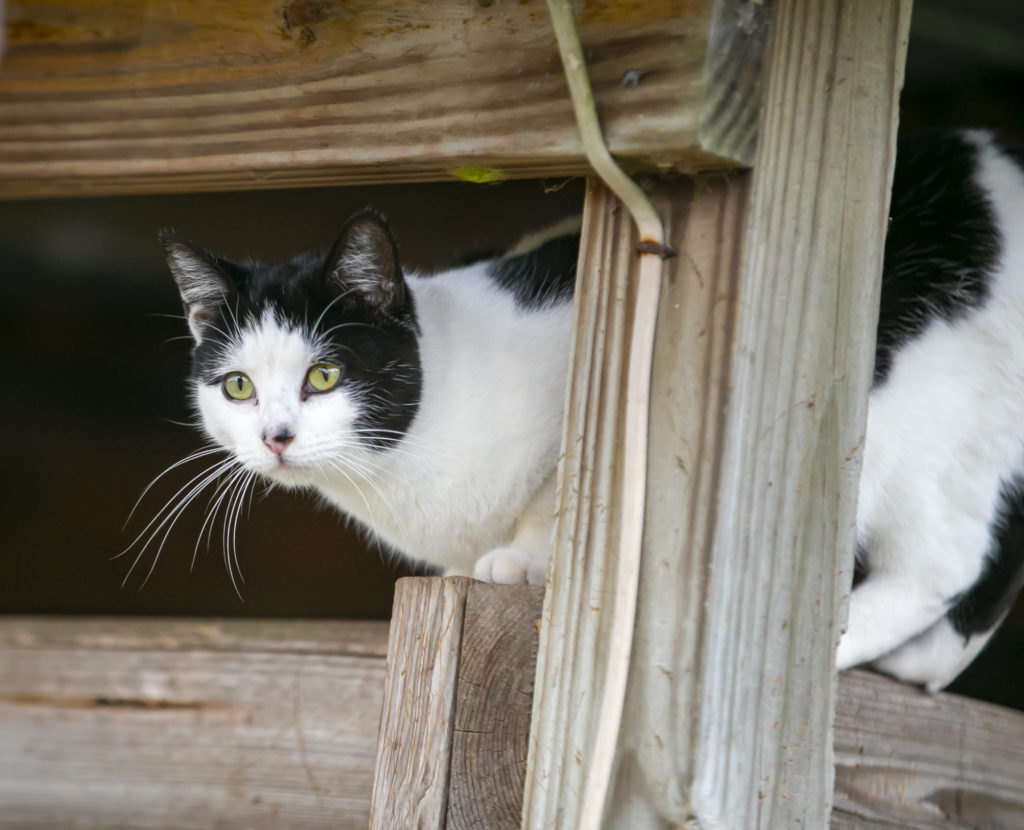
“I would label her as a guardian angel for the lost and confused,” echoes Amanda Thurber, the director of humane education for the Humane Society of Marion County. “Rosie takes the individual time to work with each one, learn their personality and their traits and find out what is going to benefit them and how they’re going to adapt to certain environments. And she always finds the right place for them. It’s almost like she’s an animal whisperer.”
“I’ve been rescuing cats, dogs and horses for the last 30 years,” Gutierrez shares. “During Hurricane Katrina we went and rescued horses and took food out to the horses that were in trouble. We moved horses from the Dakotas to Boston and New York. But now, I’m staying here because it’s necessary for me to be present to care for the animals here.”
Her focus is to get as many of the animals as she can placed in loving homes. “I never intend to keep them, but I’m aware that if they don’t get a home, they’re going to need to stay somewhere where they feel safe. And this is it,” she asserts. “That’s why I’m not only a rescue, I’m a sanctuary as well.”
She estimates that over the years she has had 500 cats come through the rescue and in the few months since beginning dog rescues she has rehabbed and placed 18 dogs in forever homes.
Most of the feral cats that have been relocated to Sweet Water have become part of the free-roaming community, coming in to eat twice a day and then heading back out into the surrounding woods. Often you will see several of them sleeping contentedly in the branches or trunks of the ancient live oaks that frame the 12-acres of the sanctuary.
Some of the more social cats, deemed “community cats” rather than strictly feral, may be placed on farms or at businesses where these natural hunters can put their skills to good use.
“It’s not an easy thing to do, to rehome feral cats. But Rosie is connected with the horse community as well. So, it helps to know who has barns and are willing to accept ferals,” offers Leslie Hinson of Sheltering Hands, a mostly volunteer-run nonprofit agency whose mission is to improve the lives of cats in Marion and Levy counties through humane care, spay/neuter services, adoptions and education.
“She’s very good at explaining to them how to properly introduce the feral cats to the new environment,’’ she adds. “She’ll help anybody she can with any issue. She started volunteering with us, then became an employee and left to start her own rescue. She’s well versed with animals and animal care. She just has a loving heart for the animals.”
“Rosie really takes the time to interact with owners and let them know, ‘Hey, you can get that animal to come out of their shell and trust you by providing it with shelter and food, but then here are the steps to grow that bond.’” Thurber states. “She really does a lot more than what the bigger organizations are able to do.”
Such was the case when I personally needed help finding homes for three feral cats after the woods in which they had been living were being cleared for new homes and following the death of their caretaker, who had been feeding them for many years. I was told by every local animal welfare entity I knew about that they were unable to help. It was Thurber who pointed me in the direction of four smaller rescues. Of the four, only Gutierrez replied and eventually accepted the cats.
“A lot of people come to me and say, ‘I went to this place, I went to this one and this one. They all say no,’” Gutierrez shares. “I just can’t say no. I have a caring heart. I get it from my mother. She was a big animal lover and a lifelong giver. She taught us all that we should give more than we take. When she died in 2016, to channel some of my energy and my grief, I decided to do this. It gives me purpose. I couldn’t save her, but I can save some of these guys.”
She often focuses on the animals who are worst off.
“I tell everybody in the rescue community, ‘Make me your last-ditch effort. A lot of big rescues call me and say, ‘We can’t place this one, can you take them?’ They come to me because these are the ones who are difficult to place, who need medical care, that couldn’t get adopted out…the ones nobody wants. And I say yes, if I have room, or even if it means that I have to make room. I find a way because I know that a lot of these animals will not be around if I don’t help.”
Thurber explains that this makes Gutierrez something of an anomaly in the rescue community.
“Shelters like the Humane Society and Marion County Animal Services, we have limited space and because we are more known, we do have a higher volume that comes through,” Thurber admits. “Let’s say, for instance, that we have eight intake cages and we end up filling all of those cages with cats or dogs that need individual attention 24/7 or we are trying to get them socialized and be able to have them move forward for adoption, then the numbers of how many we’d actually be able to help would drastically decrease because those cages would be held up and no other animals would be able to circulate through. But Rosie has that time to commit to each one of them. But she’s a one-woman show, and I know personally how much hard work goes into the upkeep of these animals. And she’s basically doing it all by herself. She is just this open door and never asks for anything in return.”
And while Gutierrez has become well-known among animal advocates and animal welfare organizations as someone to turn to in a crisis, the public knows little about her efforts. As is often the case, the bigger, more established and well-funded organizations receive the most attention and, in turn, the most financial and volunteer support.
“I’m not going to lie to you, it’s a lot of work,” she admits. “There’s no money-making scheme here. You’re never going to get rich off a rescue. And if you’re doing it right, you’re always going to be tired, exhausted, poor and overworked. That’s just the way it goes. It’s basically a 24-hour job, 365 days of the year, because if one of them is sick you still have to be here to care for them, you gotta get up no matter how cold or miserable it is because they have to eat every day and they need your attention every day.”
Indeed, it is easy to see not only how healthy and well cared for they are, but more poignantly, how happy and comfortable the animals appear.
“No matter where you go on this farm, one of the animals will show you that they are very grateful for being taken care of and loved,” Gutierrez says with pride. “What gives me satisfaction is when someone comes and sees how happy they are and they go, ‘Oh, I love that kitty. Can I adopt it?’ When they’re happy and well taken care of it shows and that that makes it worthwhile.”
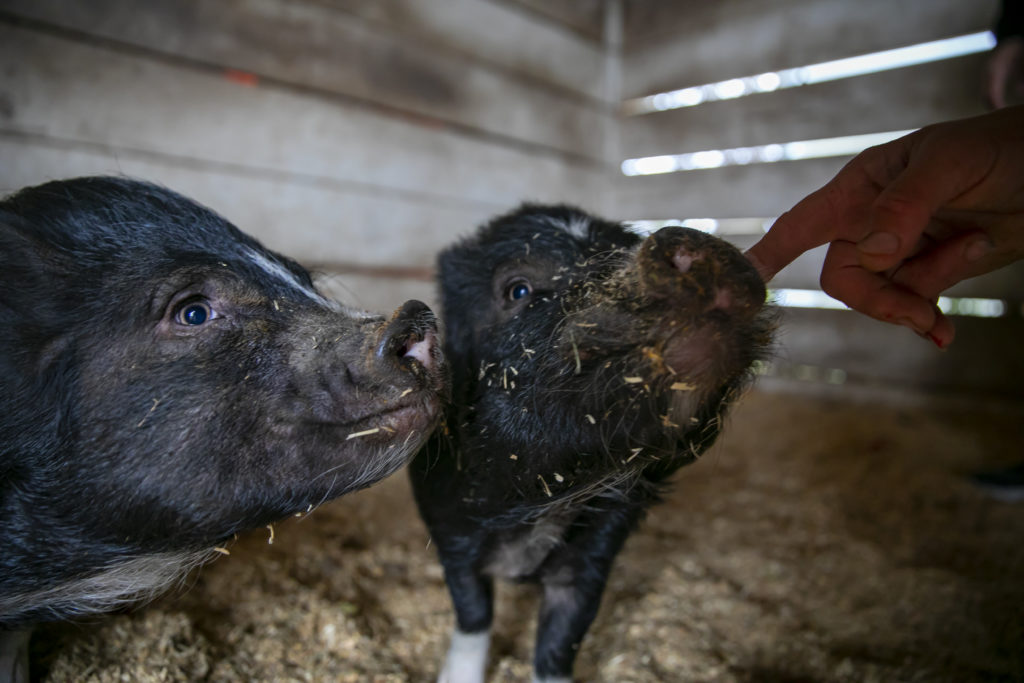
“Those animals just flock to her, the horses, the pigs and the cats. Just every creature there,” offers one of the only current volunteers at the rescue, Kathy Clevinger-Magin, who transports animals to the rescue from all over Florida. “The cats are all always climbing on her, the little ones, the big ones, they’re always all over her.”
For Clevinger-Magin, who shift ed her attention to animal welfare aft er retiring, it was her own firsthand experience with Gutierrez that moved her to begin to volunteer at the rescue.
“I was contacted by someone on Facebook asking if I could help with a momma cat and three kittens that had just been born under their utility trailer. They were afraid they would be killed by coyotes,” she recalls. “I went to get them, but I didn’t know where to take them. I tried Animal Control and the Humane Society. Nobody could take them. So, I called my friend Jaye Perrett, who worked in animal rescue for years, and she said, ‘Call Rosie.’ I’d never met her, but she said, ‘Yeah, bring them on out. I’ll take them.’ These kittens were literally just a few hours old. I drove out there and was just amazed by her and what she was doing. It made me cry, watching how she was with the animals, how hard she works. I said, ‘You’re an amazing person. My husband and I recently retired. What can we do to help you? Because you need help here.’ She got tears in her eyes and she said, ‘Nobody ever asks that.’”
Happy Endings
Since she began volunteering, Clevinger-Magin has witnessed two “miracle dog” cases. The first involved a German Shepherd whose story was posted on the social networking platform Nextdoor by Karin Snitz, a dog advocate and volunteer at Orange County Animal Services.
“He had a 7-pound tumor and they weren’t sure if he was going to live,” Clevinger-Magin recalls. “He was 7 years old and his owners had used him as a guard dog. There were places he was totally bald and his neck had no hair from where he’d lived on cement his whole life. When he needed vet care, they dumped him at a shelter. Nobody would take him anywhere in Central Florida and it was urgent because he was going to be euthanized.”
Snitz explains that Animal Services determined that the dog could only be taken on by a rescue because of the projected expenses involved with his medical care.
“I posted his story and said, ‘I have a dog here that is in desperate need, to anybody who wants to pledge,’ until I could find a rescue. That’s how people like Hank [Walker] and Rosie saw it,” Snitz explains. “Hank had a German Shepherd already. He had two, but he had lost his other German Shepherd a couple years prior. And he was touched by the story.”
“There were a lot of people involved trying to save this animal,” Walker remembers. “We got in touch with Karin and said we would pay whatever to help him and get him to where he could be adopted,” Walker says of how he and his wife, Susan Dill, got involved. “We didn’t know if he was going to live or not, but we wanted to give him an opportunity. The money part was a non-issue for us because it was about giving the dog a chance, because of the life he had led.”
Gutierrez recalls saying she would be interested in helping and although they didn’t know each other, the group banded together, each playing a vital role in saving the dog’s life. Snitz guided Gutierrez through the steps to complete the rescue process, Clevinger-Magin transported the dog from Orlando to Sweet Water, Walker and Dill provided financial support and Gutierrez took him in, arranged for the surgery to remove his tumor and nursed him back to health.
When he and his wife returned home from the trip they’d been on, Walker visited Sweet Water to check on the dog’s condition.
“Rosie, Kathy and I felt that the dog was trying to live,” he recalls. “We wanted to try to give him a chance.”
Miraculously, that chance came in the form of a forever home with the couple.
“If you saw how he looked when they picked him up from the shelter to what he looks like right now, you wouldn’t even recognize him. He’s happy and he’s cancer-free,” Walker says proudly of the dog they now call Kobe. “He’s an entirely different dog.”
Of his experience with Gutierrez, he offers: “She’s a very caring person when it comes to any kind of animal. And if no one else is willing to take them, she’ll keep them herself. When we decided to take the dog, she told me that if we ever chose not to take care of him, that she wanted him back. That tells you how she is, right? She’s one of those people who if she had $100 in her pocket and it was between feeding the animals or feeding herself, she would feed the animals. That’s Rosie. She does her thing and never complains, never asks for anything, but she could do so much more if people knew about what she’s trying to do there.”
Another dog from Orange County Animal Services that was saved from euthanasia was a pit bull that had been subjected to terrible cruelty.
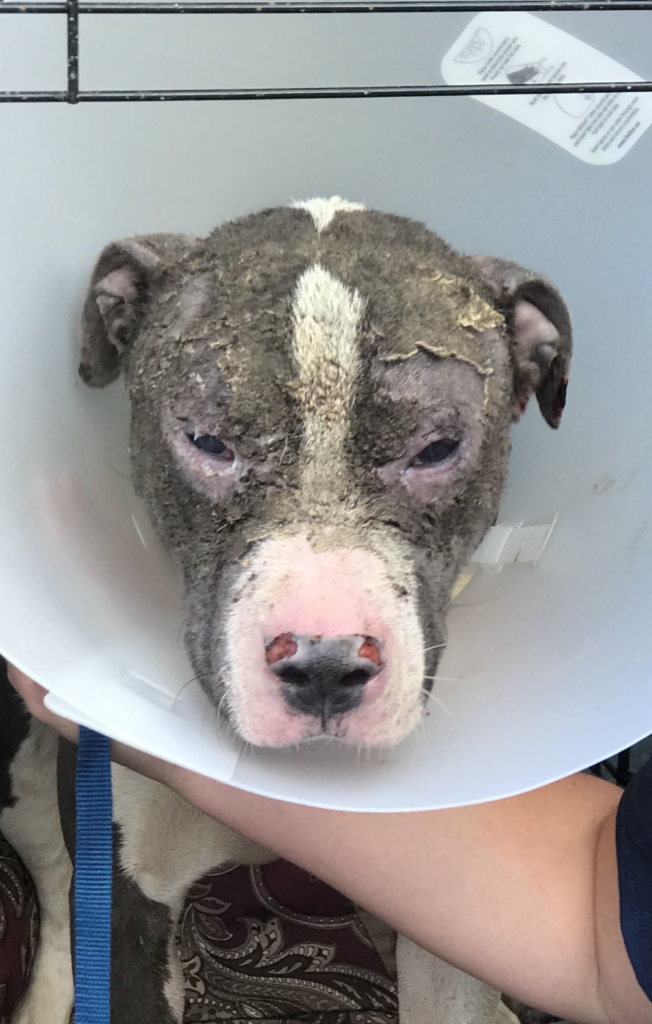
attacked with acid in 2021.
“Someone had poured acid over three-quarters of his body,” Gutierrez explains. “His head was raw, bleeding and cracked. They had poured acid on his rear end and on his genitals, so all that was burned as well. The biggest concern was that he would be blind, because when they poured the acid, it ran into his eyes. He had two major corneal burns. But eyes are amazing. They will slough off the dead tissue and eventually come back to almost normal.”
“He only had like three days before he had to be out of the facility because he was in such pain,” Snitz recalls. “They don’t have that level of veterinary care available physically on site. He was an absolute mess. I sent Rosie one picture of him, and she didn’t hesitate. She sent Kathy to come get him.”
“He was a young dog that didn’t need to die,” Gutierrez insists. “He needed a lot of medicating, like three or four times a day with the eye drops and the cream. But we got his vision to return 80% in one eye and 100% in the other.”
She cared for him for four months and was eventually able to place him with a “wonderful, young family” who named him Slate.
Melissa Pedersen says she and her husband, Eric, knew immediately.
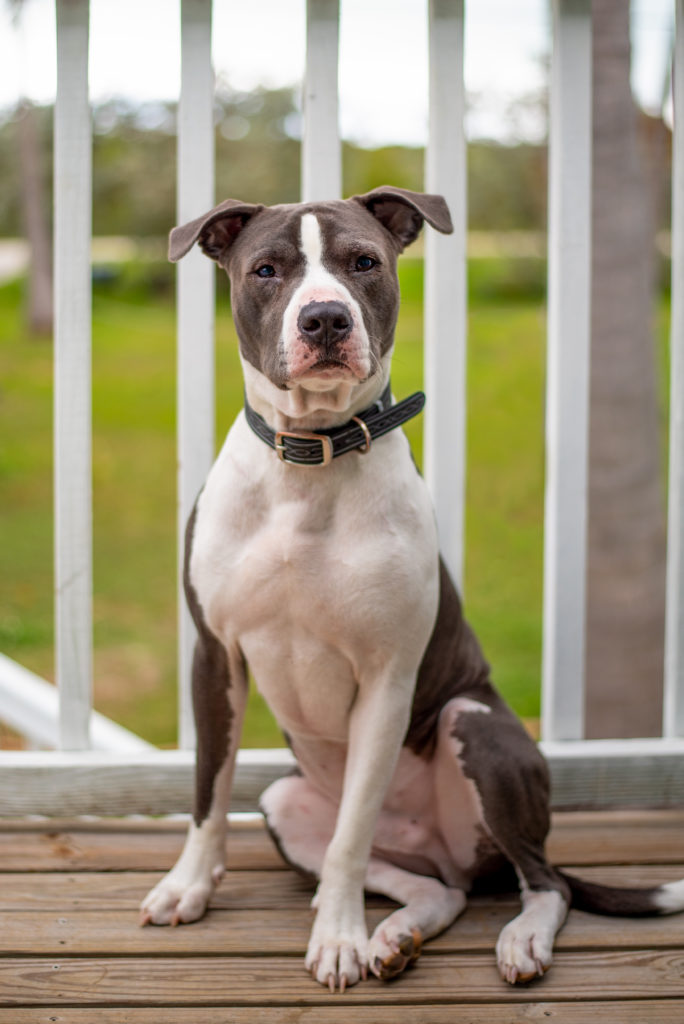
“There was just something about him,” she recalls. “He’s doing super well. We live on a beach in the Keys, so he gets to go on walks, play in the water and just hang out. We have another pit bull who is about 10 and they’re best friends.”
The Future
“I have a vision for this place, if I can ever get it the way I want it,” Gutierrez shares. “My idea is to eventually turn this into an enrichment center.”
She wants to share her knowledge about caring for animals with others and believes animals have important lessons to offer about compassion, patience and our place in the world.
“I’m never alone,” Gutierrez says. “They are always with me. It starts when I sit on the porch and have my coffee in the morning with all the kitties around me. It’s such a Zen moment. I’m also never without love or affection here.”
And all those creatures once considered “misfit toys” now have a name and perhaps most important of all, a safe and loving place to call home.
Ways to Help
Donate: Sweet Water is a 501(c)(3) nonprofit organization and accepts monetary and in-kind donations. The rescue is on the waiting list for the Chewy.com Food Bank through VOCAL (the Voices of Change Animal League) but currently must purchase food so pet food, horse feed, cat litter and hay are needed on a regular basis. Also needed is a high cube shipping container to store feed and supplies, and new fencing.
Volunteer: One of the greatest needs is for able-bodied volunteers who can help with regular maintenance and daily chores. There is an immediate need for volunteers to help with roof and fence repairs.
For more information, visit Sweet Water Rescue and Rehab on Facebook or contact them by sending an email to sweetwaterrnr@gmail.com or calling (352) 359-5430.






